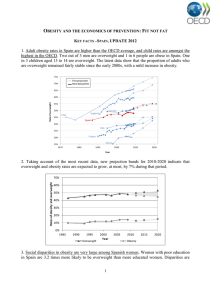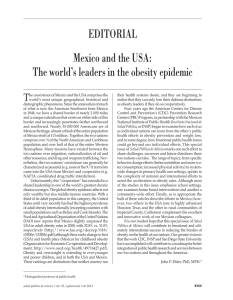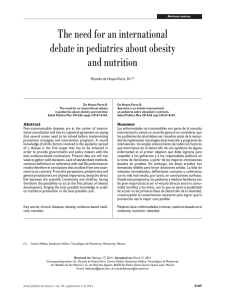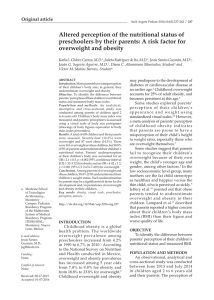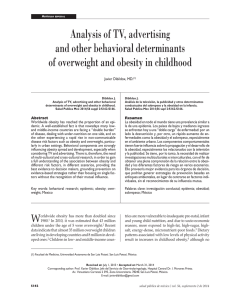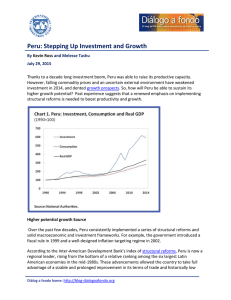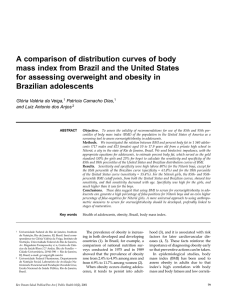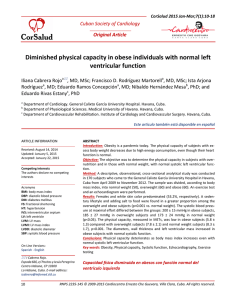Prevalence of childhood overweight and obesity and associated
Anuncio
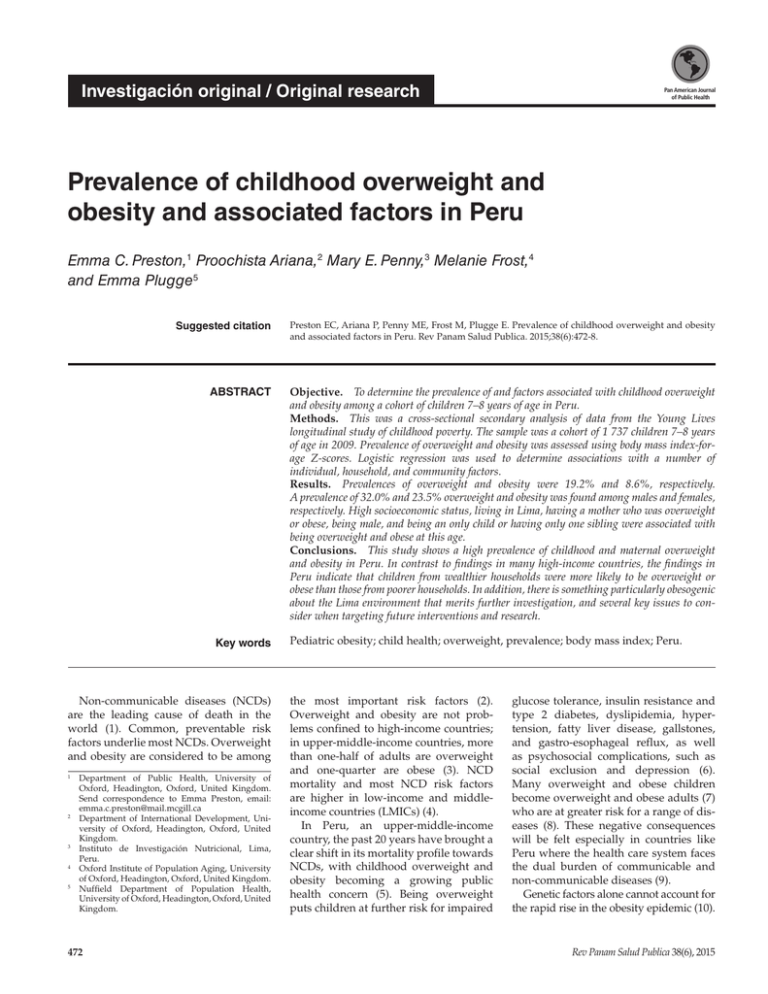
Investigación original / Original research Pan American Journal of Public Health Prevalence of childhood overweight and obesity and associated factors in Peru Emma C. Preston,1 Proochista Ariana,2 Mary E. Penny,3 Melanie Frost,4 and Emma Plugge5 Suggested citation Preston EC, Ariana P, Penny ME, Frost M, Plugge E. Prevalence of childhood overweight and obesity and associated factors in Peru. Rev Panam Salud Publica. 2015;38(6):472-8. ABSTRACT Objective. To determine the prevalence of and factors associated with childhood overweight and obesity among a cohort of children 7–8 years of age in Peru. Methods. This was a cross-sectional secondary analysis of data from the Young Lives longitudinal study of childhood poverty. The sample was a cohort of 1 737 children 7–8 years of age in 2009. Prevalence of overweight and obesity was assessed using body mass index-forage Z-scores. Logistic regression was used to determine associations with a number of individual, household, and community factors. Results. Prevalences of overweight and obesity were 19.2% and 8.6%, respectively. A ­prevalence of 32.0% and 23.5% overweight and obesity was found among males and females, respectively. High socioeconomic status, living in Lima, having a mother who was overweight or obese, being male, and being an only child or having only one sibling were associated with being overweight and obese at this age. Conclusions. This study shows a high prevalence of childhood and maternal overweight and obesity in Peru. In contrast to findings in many high-income countries, the findings in Peru indicate that children from wealthier households were more likely to be overweight or obese than those from poorer households. In addition, there is something particularly o­ besogenic about the Lima environment that merits further investigation, and several key issues to consider when targeting future interventions and research. Key words Non-communicable diseases (NCDs) are the leading cause of death in the world (1). Common, preventable risk factors underlie most NCDs. Overweight and obesity are considered to be among Department of Public Health, University of Oxford, Headington, Oxford, United Kingdom. Send correspondence to Emma Preston, email: [email protected] 2 Department of International Development, Uni­ versity of Oxford, Headington, Oxford, United Kingdom. 3 Instituto de Investigación Nutricional, Lima, Peru. 4 Oxford Institute of Population Aging, University of Oxford, Headington, Oxford, United Kingdom. 5 Nuffield Department of Population Health, University of Oxford, Headington, Oxford, United Kingdom. 1 472 Pediatric obesity; child health; overweight, prevalence; body mass index; Peru. the most important risk factors (2). Overweight and obesity are not problems confined to high-income countries; in upper-middle-income countries, more than one-half of adults are overweight and one-quarter are obese (3). NCD mortality and most NCD risk factors ­ are higher in low-income and middle-­ income countries (LMICs) (4). In Peru, an upper-middle-income country, the past 20 years have brought a clear shift in its mortality profile towards NCDs, with childhood overweight and obesity becoming a growing public health concern (5). Being overweight puts children at further risk for impaired glucose tolerance, insulin resistance and type 2 diabetes, dyslipidemia, hyper­ tension, fatty liver disease, gallstones, and gastro-esophageal reflux, as well as ­ psychosocial complications, such as social exclusion and depression (6). Many overweight and obese children become overweight and obese adults (7) who are at greater risk for a range of diseases (8). These negative consequences will be felt especially in countries like Peru where the health care system faces the dual burden of communicable and non-communicable diseases (9). Genetic factors alone cannot account for the rapid rise in the obesity epidemic (10). Rev Panam Salud Publica 38(6), 2015 Preston et al. • Childhood overweight and obesity in Peru In order to address this challenge and inform appropriate interventions, context-specific information is needed ­ concerning the prevalence of overweight and obesity and its association with factors such as gender, age, physical ­ activity, diet, sleep, socioeconomic status, community safety, and urban setting. Although there is a dearth of ­ research on NCDs in LMICs (11), there is a particular lack of research on risk factors for childhood overweight and ­ obesity in Peru (12, 13). The objectives of this study were to determine the prevalence and associated factors of overweight and obesity in a pro-poor cohort of school-aged children in Peru and to determine the individual, household, and community factors associated with childhood overweight and obesity in this context. MATERIALS AND METHODS This was a cross-sectional analysis of data from the Peruvian cohort of the Young Lives longitudinal study conducted in 2009 (14). Study sample and data The Young Lives team used multistage, cluster-stratified, random sampling to select the two cohorts of children; randomization occurred at the level of the household within a cluster, as well as at sentinel site level (a district in Peru). Clusters of equal population were randomly-selected excluding districts located in the top 5% of the poverty map developed in 2000 by the Fondo Nacional de Cooperación para el Desarrollo (the National Fund for Development and Social Compensation (14, 15). A total of 1 737 children surveyed by Young Lives in 2009 had the complete data records required for the analysis. These children were 7–8 years of age at the time of the data collection (born in December 2000–June 2002), part of the “younger cohort” of the Young Lives sample. Study measures and variables Body Mass Index (BMI) Z-scores were used as the outcome measure for assessing overweight and obesity. BMI is an inexpensive and reliable method of screening for weight categories that may lead to health problems (16). The 2007 Rev Panam Salud Publica 38(6), 2015 World Health Organization (WHO) international growth reference curves for children 5–19 years of age described by De Onis were used to compare children of the same age and gender (16). “Overweight (in this case including obese)” and “Obese” variables were defined as BMI-for-age Z-scores of ≥ 1 and ≥ 2, respectively. Trained fieldworkers measured the children’s height and weight (17). The Young Lives data comprises child, household, and community questionnaires. All three questionnaires used in field data collection and the available data are on the Young Lives website (www.younglives.org.uk/). The independent variables selected for analysis from the available dataset were among those shown by international peer-­ reviewed literature to be associated with childhood overweight and obesity. Individual demographic variables used for this analysis included gender and ethnicity. A child’s ethnicity was categorized as either “Indigenous” (i.e., of Quechua, Aymara, or Amazonian descent) or “Mestizo/Non-Indigenous” (i.e., of mixed, European, or African descent). Physical activity behavior was assessed based on method of transportation to school and caregiver-reported weekly physical activity. Transportation to school was classified either as “Active” if the child went by foot or bike, or “Not active” if by motorized transport. Caregivers were asked, “During the last 7 days, on how many days was your child physically active for at least 60 minutes at one time?” The physical activity variable was dichotomized as, “Physically active for 60 minutes at a time every day of the week” or “Physically active for 60 minutes at a time less than every day of the week.” Caregivers were asked, “On average, how many hours did the child sleep per night.” The sleep variable was dichotomized as, “10 hours or more of sleep per night” or “Less than 10 hours of sleep per night.” Sugar-sweetened beverage (SSB) consumption, as reported by caregivers, was also included. Family characteristics included maternal overweight and obesity, education of the primary caregiver, socioeconomic status (SES), and number of siblings. Maternal BMI was calculated using weight in kilograms (kg) divided by height in meters (m) squared. BMI was categorized as “Overweight and obese” Original research when ≥ 25kg/m2 and “Not overweight or obese” when it was < 25kg/m2, according to WHO recommended cut-offs (18). Maternal education was categorized into four groups according the classification methods of the Peruvian education system (19). Consumer durables (CD) ­ index quartiles, based on the number of assets owned by the household, were used to assess SES (20). The CD index was chosen as the other components of the Young Lives’ Wealth Index were biased towards urban indicators of wealth within the Peruvian context. The quartiles were created according to the CD index score: First (the poorest with a score of < 0.25); Second (0.25–0.50); Third (0.50–0.75); and Fourth (the wealthiest, with a CD score of 0.75–1.00). Source of drinking water was categorized according to the WHO/UNICEF Joint Monitoring Program for Water Supply and Sanitation guidelines (21). Peru is composed of distinct geographic areas. The seven distinct ‘­ regional’ categories defined by the Instituto Nacional de Estadística e Informática (Lima, Peru; INEI) were used for the study (22). Each community was defined as being either “Urban” or “Rural” on the basis of national census data from the INEI. Child reported safety was dichotomized based on the statement, “I feel safe when I go out of the house on my own.” Those that ­responded “Disagree” or “Disagree strongly” were classified as living in a community that they considered “Not safe.” Those that responded “Strongly agree,” “Agree,” or “More-or-less” were classified as living in a community that they considered “Safe.” Data analysis The study analysis was conducted using Stata®/MP11 (StataCorp LP, College Station, Texas, United States). Simple descriptive analysis was employed to calculate the unadjusted odds ratios (OR) for each independent variable. Those with a P value less than 0.2 were included in the multivariate model (23). Logistic regression was carried out in a forward stepwise manner using the dichotomous outcome variable of “Overweight and obese” or “Not overweight or obese,” with the independent variables that were shown to have the most significant effect in b ­ivariate analyses. 473 Original research Ethics approval Ethical approval for this study was obtained from the University of Oxford Central University Research Ethics Committee (CUREC, Oxford, United Kingdom) and the Comité de Ética del Instituto de Investigación Nutricional (Ethics Committee of the Institute for Nutritional Research, Lima, Peru). Collective consent was sought within communities, and written, informed consent was obtained from all caregivers or guardians. RESULTS Of the 1 943 children from 7–8 years of age surveyed in 2009, a total of 1 737 (89.4%) had complete data and were included in the study analysis. The sample was 50.4% (n = 875) male. A minority of children (15.9%, n = 276) were indigenous of whom 87.3% (n = 241) were of Quechua ancestry. In terms of prevalence, 27.8% (n = 483) were overweight or obese and 8.6% (n = 149) were obese. The mean BMI-for-age Z-score was 0.5 (95% Confidence Interval [95%CI] = -4.7–4.0) with a standard deviation of 1.0. The distribution of the BMI-for-age Z-scores was shifted right, positively skewed with a value of 0.18 (P = 0.003) and was leptokurtic with a kurtosis of 4.62 (P < 0.001), indicating that the proportion of BMI Z-scores above the overweight and obesity cut-off points were higher than in a normal distribution. Over three-quarters of caregivers reported that their child either walked or bicycled to school, although only 0.6% of those children used bicycles. Only onethird (33.1%, n = 574) of caregivers reported that their children were physically active for at least 60 minutes at a time all 7 days of the week. With respect to child SSB consumption frequency, 56 (3.2%) of caregivers reported that their child drank SSBs “daily;” 328 (18.9%) reported they drank SSBs 2–3 times each week; and 227 (13.1%) said they never drank SSBs. Well over one-half (58.0%, n = 1 007) of all caregivers reported that their children had at least the recommended 10 hours of sleep per night for children in this age group. The majority of mothers in the study sample (65.3%) were found to be ­overweight or obese. Nearly 30% (n = 516) had not completed their primary 474 Preston et al. • Childhood overweight and obesity in Peru education, while just over 10% (n = 188) had completed post-secondary education. Over one-half of children (n = 910) were either an only child or had only one sibling. Nearly one-third of households (n = 551) were in the lowest SES category, while less than 5% were in the relatively wealthiest quartile (n =79). The majority of households (92.7%) had access to an “improved” source of drinking water. Most children (72.6%, n = 1 262) lived in an urban area at the time of the 2009 survey, with over 15% (n = 274) of the cohort residing in metropolitan Lima. Overall, 37.6% (n = 653) of the cohort lived on the coast, 47.4% (n = 824) lived in the mountain area, and 15.0% (n = 260) lived in the jungle area. When asked if they feel safe when they leave their house, 38.6% (n = 663) said that they did not. After adjusting for the range of individual, household, and community variables described, being male (odds ration [OR] = 1.69), having an overweight or obese mother (OR = 1.76), having one or no ­siblings (OR = 1.50), being in the wealthiest two categories (OR = 2.23 and 3.36, respectively), and living in metropolitan Lima (OR = 2.70) were found to be ­significantly associated with childhood overweight and obesity (Table 1). Ethnicity, transport to school, days physically active, SSB consumption, sleep, maternal education, source of drinking water, and community safety lost their significance. DISCUSSION The combined prevalence of 27.8% overweight and obesity found in this study is comparable to rates in other parts of Latin America. A recent systematic review found that across Latin America, national combined prevalence of overweight and obesity with the WHO 2007 classification method ranged from 18.9%–36.9% in children 5–11 years of age (24). More specifically, the prevalence of overweight and obesity in recent surveys conducted since 2009 was 33.5% in Brazil, 18.9% in Colombia, and 34.5% in Mexico (24). We found that children in the highest socioeconomic groups were more likely to be overweight and obese. Traditionally, in LMICs the prevalence of overweight and obesity among the poorest people has been limited by the scarcity of affordable food and the high-energy demands of daily life (25). However, this paradigm is changing in many LMICs. With economic development, quantity of food is less of a limiting factor. An individual’s energy balance is increasingly influenced by the quality of food available and recreational levels of energy expenditure (25). A number of studies have shown that the burden of overweight and obesity in LMICs tends to shift to groups with lower SES as the countries develop economically (26). Peru is an upper-­ middle-income country (27). As such, a greater prevalence of overweight and obesity among the children with a lower SES would be expected (28), as has been found among schoolchildren in Chile (29). However, a positive relationship has been found previously among schoolchildren in urban areas of Peru and Colombia and among adult populations in Peru (30–32). As Young Lives is a pro-poor cohort, the wealthiest quartile in the study is not representative of the wealthiest quartile in Peru. Another Peruvian study showed that adults with the lowest SES had a 4-fold increased risk of having multiple cardiovascular risk factors compared to the highest SES (33). This suggests that there are other social and environmental factors that modify the relationship between SES, overweight and obesity, and the future risk for chronic diseases. Income inequality in itself has been associated with numerous negative health and psychosocial outcomes, such as lower life expectancy, higher homicide rates, and lower self-rated health (34). A study by Pickett found that income inequality was associated with increased rates of adult obesity in high-income countries (HICs) (35). When compared to the jungle, mountains, and coast regions, Lima has the highest prevalence of childhood overweight and obesity indicating that overweight and obesity are not yet a nationally-distributed problem. This relationship is consistent with previous studies of Peruvian populations (30). There is considerable research investigating the relationship between urban environments and overweight in chil­ dren and adults (36, 37). Urban diets tend to be higher in processed food, fat, animal products, and sugar compared to their rural counterparts (38). Numerous fastfood restaurants, convenience stores, and marketing of unhealthy food choices can hinder good nutrition in urban areas (39). The contrasts between urban and rural eating patterns are more marked in Rev Panam Salud Publica 38(6), 2015 Preston et al. • Childhood overweight and obesity in Peru Original research TABLE 1. Odds ratios (OR) and 95% confidence intervals (95%CI) for independent variables and child overweight and obesity in a sample of 1 737 children 7–8 years of age, Peru, 2009 No. % Unadjusted OR for child overweight and obesity (95% CI) 862 875 203 280 42.0 58.0 1.00 1.53 (1.24–1.89)a 1.69 (1.33–2.13)a Mestizo/Non-Indigenous Indigenous 1 461 276 435 48 90.1 9.9 1.00 0.50 (0.36–0.69)a 1.06 (0.72–1.57) Transport to school Active Inactive 1 295 423 322 155 67.5 32.5 1.00 1.75 (1.38–2.21)a 0.94 (0.71–1.23) Days physically active/ week 7 days/week <7 days/week 574 1 156 135 346 28.1 71.9 1.00 1.39 (1.10–1.75)b 1.18 (0.92–1.53) Frequency of child’s SSBd consumption Never < Every 2 weeks Every 2 weeks Once/week 2–3 times/week Daily 227 293 258 568 328 56 43 78 72 146 123 18 8.9 16.2 14.9 30.2 25.5 3.7 1.00 1.55 (1.02–2.37)c 1.66 (1.08–2.54)c 1.48 (1.01–2.17)c 2.57 (1.72–3.83)a 2.03 (1.06–3.89)c 1.20 (0.76–1.90) 1.24 (0.77–1.98) 0.96 (0.63–1.47) 1.53 (0.97–2.39) 1.24 (0.61–2.52) Sleep ≥10 hours/night <10 hours/night 1 007 730 255 228 52.8 47.2 1.00 1.34 (1.08–1.65)b 1.01 (0.80–1.28) Maternal overweight and obesity BMIe <25kg/m2 BMI ≥25kg/m2 603 1 134 116 367 24.0 76.0 1.00 2.01 (1.58–2.55)a 1.76 (1.35–2.29)a Maternal education Incomplete primary Complete primary Complete secondary Complete post-secondary 516 544 489 188 105 115 179 84 21.7 23.8 37.1 17.4 1.00 1.05 (0.78–1.41) 2.26 (1.70–3.00)a 3.16 (2.21–4.52)a 1.00 0.62 (0.44–0.87)b 0.87 (0.61–1.24) 1.15 (0.74–1.80) Siblings More than one sibling One sibling or only child 827 910 169 314 35.0 65.0 1.00 2.05 (1.65–2.55)a 1.50 (1.17–1.93)b SES category First (Poorest) Second Third Fourth (Wealthiest) 551 548 559 79 75 135 231 42 15.5 28.0 47.8 8.7 1.00 2.07 (1.52–2.83)a 4.47 (3.32–6.01)a 7.20 (4.35–11.93)a 1.00 1.33 (0.92–1.93) 2.23 (1.50–3.32)a 3.36 (1.82–6.21)a Source of drinking water Unimproved Improved 126 1 607 16 467 3.3 96.7 1.00 2.82 (1.65–4.81)a 1.71 (0.96–3.05) Area of residence Rural jungle Rural mountains Rural coast Urban jungle Urban mountains Urban coast (excluding Metro Lima) Metropolitan Lima 92 357 26 168 467 352 275 12 53 8 28 106 133 143 2.5 11.0 1.7 5.8 22.0 27.5 29.6 0.37 (0.20–0.69)b 0.39 (0.28–0.53)a 1.16 (0.50–2.68) 0.49 (0.32–0.75)b 0.70 (0.54–0.89)b 1.80 (1.40–2.30)a 3.58 (2.74–4.66)a 1.00 1.06 (0.53–2.15) 1.77 (0.60–5.19) 0.70 (0.32–1.53) 0.96 (0.46–1.86) 1.81 (0.90–3.66) 2.70 (1.32–5.53)b Community safety Safe Not safe 1 057 663 257 220 53.9 46.1 1.00 1.55 (1.25–1.92)a 1.21 (0.96–1.54) Total No. Independent variable Gender Female Male Ethnicity of the child f Overweight and obesity Adjusted OR for child overweight and obesity (95% CI) Source: Prepared by the authors using unpublished, original data and analysis. a P ≤0.05 and >0.01. b P ≤0.01 and >0.001. c P ≤0.001. d Sugar-sweetened beverages. e Body mass index f Socioeconomic status LMICs because market penetration into rural areas is less common. In addition, the population of Lima expanded rapidly in 1980–1990 due to guerrilla terrorism, which disproportionately affected rural communities and resulted in rapid urban migration (40). This unplanned urbanization greatly affected the built and social environment (38). It is also likely to have affected psychosocial factors such as stress, cultural alienation, loss of self-esteem, and community support (41). Rev Panam Salud Publica 38(6), 2015 It has been estimated that parental obesity more than doubles the risk of adult obesity among both obese and non-obese children (42). The relationship between maternal and child obesity found in this study has been shown in HIC and LMIC settings (43). In Bogota, Colombia, school children were 3.5 times more likely to be overweight if their mother was obese than if her BMI was normal (31). Parents play a large role in shaping their children’s physical ­activity, eating patterns, and dietary composition (44, 45). Weight gain in pregnancy may also contribute to this relationship. Children of women who gained an excessive amount of weight in pregnancy were more likely to be overweight (46). The Young Lives study does not have information on maternal weight gain in pregnancy, but there was a high prevalence of maternal overweight generally. The association of male gender with overweight and obesity was also found in a 2008 study school children 7–12 years of age in metropolitan Lima (30). Recent 475 Original research data for Brazil also showed that boys had a higher prevalence of obesity than girls (47). Similarly, in Mexico, a study of children 5–11 years of age based on data from the 2012 National Health Survey also showed higher levels of overweight and obesity in boys (36.9%) compared to girls (32.0%) (48). Possible reasons for the association between male gender and overweight and obesity include cultural factors such as the desire to have a “big, strong boy,” pressure on young girls to be slim, and the traditional social subordination of women that can affect access to quantity and quality of food (49). There is some evidence for bias in food distribution towards male children in other Latin American countries, particularly in the context of food shortage (50). In addition, women in Latin America often face a heavy social burden, and young women may be expected to do more housework than their male counterparts, contributing to a higher level of physical activity (49). Having one sibling or being an only child was also associated with a greater likelihood of being overweight or obese, findings consistent with those of other studies of childhood overweight in HICs (51, 52). A Canadian study found that the odds of a child being overweight decreased by approximately 11% for each additional sibling (52). Being an only child or having only one sibling may mean there is more food available in the household, since having more siblings may mean sharing among more children. There may also be an effect on physical activity since an only child or having only one sibling means fewer playmates are available. Also, parents may feel more comfortable allowing their children to play outside if they are accompanied by siblings. Study limitations The available data provided information on a range of important variables, but there are inherent limitations when performing secondary data analysis on an existing data set. Some important measures of interest, such as detailed junk food consumption and time spent watching television, were not available. Nutritional and environmental imbalances in utero and early postnatal life are likely to contribute to the obesity epidemic through a number of mechanisms. The more rapid and earlier an infant gains excess weight, the greater the 476 Preston et al. • Childhood overweight and obesity in Peru likelihood for undesirable weight in subsequent years (53). Infants born with a lower birthweight who later develop obesity also appear to be at the highest risk for cardiovascular morbidities in the long term (54). We did not include birthweight as it was only documented in approximately two-thirds of cases in the Young Lives cohort. Of that two-thirds, the percentage of low birthweight was similar in urban and rural areas. This does not explain the difference in prevalence between urban and rural children in the Young Lives study. Since there are large income inequalities in Peru (27), another limitation of this study is that it did not investigate the relationship between SES and overweight and obesity in the wealthiest 5%, or explore the degree to which economic inequality may lead to increased overweight and obesity among the middle class. The cohort is a pro-poor sample that intentionally excluded communities in the wealthiest 5% from its sampling procedure, e.g., districts from “wealthy” sectors of Lima. Therefore, the “richest” SES category in this sample does not represent the very wealthiest segment of the Peruvian population, merely the ­better-off families in the cohort. Previous analytical work has shown that the Young Lives households are very similar to the average household in Peru, even when the full spectrum of SES is included, and that the sample covers the full diversity of children. The only difference found was that Young Lives households tend to have better access to some services. Furthermore, measures of socioeconomic status are imperfect. This present study used what was available from the existing dataset, the Young Lives’ Wealth Index, which is made up of several sub-indices including Housing Quality, CD index, and Services. The CD index was chosen because other components of the Index were biased towards urban indicators of wealth within the Peruvian context. For example, data from the Living Standards Measurement Survey (20) indicate that even the wealthiest households in rural areas have less access to some services—only 54% of households in the richest rural quintile have access to piped water compared to 81% of households in the poorest urban quintile. The corresponding figures for access to sewage systems are 20% and 70%, respectively (55). Conclusions The implications of this study for the health care system in Peru are considerable, but the effects of obesity are likely to extend beyond health care infrastructure. Obesity could compromise economic growth due to short-term absences from work, long-term disability, and premature death (56–58). There is ­evidence to suggest that this problem will worsen with increasing development, unless preventive measures are taken (59). We have used data from a well-established cohort study to establish the prevalence of overweight and obesity and examine the risk factors for obesity in a sample of Peruvian children. The prevalence of overweight and obesity were 19.2% and 8.6%, respectively. In an upper-middle-­income country such as Peru, this high prevalence of childhood overweight and obesity is a considerable public health concern with implications for the wellbeing of these children now and in the future. High socioeconomic status, living in Lima, having a mother who is overweight or obese, being male, and being an only child or having only one sibling were associated with being overweight and obese at this age. By identifying associated factors, this study has highlighted some key issues to consider in relation to childhood obesity in developing countries and indicates a number of directions for further research. Nationally representative investigations of the relationships among SES, income inequality, and childhood overweight and obesity are needed to fully understand this public health concern. Acknowledgements. We would like to acknowledge the tremendous support of our colleagues at the Instituto de Investigación Nutricional (Lima, Peru) and at the Young Lives Study in Oxford (United Kingdom) and in Peru. Many thanks are due to the Young Lives children, families, and community members, and the fieldworkers who have made this research possible. Conflict of interests. None. Disclaimer. Authors hold sole responsibility for the views expressed in the manuscript, which may not necessarily reflect the opinion or policy of the RPSP/ PAJPH and/or PAHO. Rev Panam Salud Publica 38(6), 2015 Preston et al. • Childhood overweight and obesity in Peru Original research REFERENCES 1.Alwan A, MacLean DR, Riley LM, d’Espaignet ET, Mather CD, Stevens GA, et al. Monitoring and surveillance of chronic non-communicable diseases: progress and capacity in high-burden countries. Lancet. 2010;376(9755):1861–8. 2. World Health Organization. Global health risks, 2009. Available from: www.who. int/healthinfo/global_burden_­disease/ global_health_risks/en/ Accessed on 25 February 2012. 3.World Health Organization. Noncommunicable diseases country profile–Peru, 2011. Available from: www.who.int/ nmh/countries/per_en.pdf Accessed on 30 March 2012. 4.World Health Organization. Global status report on non-communicable diseases, 2010. Geneva: WHO; 2011. 5. Huicho L, Trelles M, Gonzales F, Mendoza W, Miranda J. Mortality profiles in a country facing epidemiological transition: an analysis of registered data. BMC Public Health. 2009;9:47. 6. Han J, Lawlor D, Kimm S. Childhood obesity. Lancet. 2010;375(9727):1737–48. 7.Guo S, Wu W, Chumlea W, Roche A. Predicting overweight and obesity in adulthood from body mass index values in childhood and adolescence. Am J Clin Nutr. 2002;76(3):653–8. 8.Biro F, Wien M. Childhood obesity and adult morbidities. Am J Clin Nutr. 2010;91(5):1499S-505S. 9.Popkin B. The nutrition transition and obesity in the developing world. J Nutr. 2001;131(3):871S-3S. 10.Ebbeling C, Pawlak D, Ludwig D. Child­ hood obesity: public-health crisis, common sense cure. Lancet. 2002;360(9331): 473–82. 11.Di Cesare M, Khang Y-H, Asaria P, Blakely T, Cowan MJ, Farzadfar F, et al. Inequalities in non-communicable diseases and effective responses. Lancet. 2013;381(9886):585–97. 12.Pajuelo-Ramirez J, Miranda-Cuadros M, Campos-Sánchez M, Sánchez-Abanto J. Prevalence of overweight and obesity among children under five years in Peru, 2007–2010. Rev Peru Med Exp Salud Publica. 2011;28(2):222–7. 13.Mispireta ML. Determining factors of overweight and obesity in children at school age in Peru. Rev Peru Med Exp Salud Publica. 2012;29(3):361–5. 14.Barnett I, Ariana P, Petrou S, Penny ME, Duc LT, Galab S, et al. Cohort profile: the Young Lives Study. Int J Epidemiol. 2013;42(3):701–8. 15.Escobal J, Flores E. An assessment of the Young Lives sampling approach in Peru. Young Lives Technical Note No.3; 2008. Available from: www.younglives.org.uk/ publications/TN/assessment-younglives-sampling-approach-peru/ a n - a s s e s s m e n t - o f - t h e - y o u n g - l i v e s -­ sampling-approach-in-peru Accessed on 20 September 2009. 16.de Onis M, Onyango A, Borghi E, Siyam A, Nishida C, Siekmann J. Development of Rev Panam Salud Publica 38(6), 2015 a WHO growth reference for school-aged children and adolescents. Bull WHO. 2007;85(9):649–732. 17.Young Lives Methods Guide. The Longi­ tudinal Survey, 2011. Available from: www.younglives.org.uk/files/­methodsguide/methods-guide-the-­longitudinalsurvey. Accessed on 28 December 2015. 18.World Health Organization Expert Committee. Physical status: the use and interpretation of anthropometry; 1995. ­ Technical Report Series No. 854. Available from: www.who.int/childgrowth/publications/physical_status/en/index.html Accessed on 10 October 2010. 19.Ministerio de Educación. Portal de transparencia del Ministerio de Educación. Avail­able from: www.minedu.gob.pe Accessed on 30 Dec 2011. 20.Instituto Cuánto. Peru National Living Standards Measurement Survey. Lima: Instituto Cuánto; 2000. 21. World Health Organization/United Nations Children’s Emergency Fund Joint Monitoring Program for Water Supply and Sanitation. Core questions on drinking-water and sanitation for household surveys. Geneva: WHO/UNICEF; 2006: 1–25. 22. Instituto Nacional de Estadística e Informática. Censo Nacional Universitario 2010. Available from: www.inei.gob.pe Accessed on 30 December 2011. 23.Hosmer D, Lemeshow S. Applied logistic regression. 2nd ed. Hoboken (New Jersey, United States of America): WileyInterscience; 2000. 24.Rivera JA, de Cossio TG, Pedraza LS, Aburto TC, Sánchez TG, Martorell R. Childhood and adolescent overweight and obesity in Latin America: a systematic review. Lancet Diabetes Endocrinol. 2014;2(4):321–32. 25. Caballero B. A nutrition paradox–­ underweight and obesity in developing countries. New Engl J Med. 2005;352: 1514–6. 26.Monteiro CA, Moura EC, Conde WL, Popkin BM. Socioeconomic status and obesity in adult populations of developing countries: a review. Bull WHO. 2004; 82(12):940–6. 27.World Bank. The World Bank Country Database–Peru. 2010. Available from: http://data.worldbank.org/country/ peru Accessed on 15 February 2012. 28. Jones-Smith J, Gordon-Larsen P, Siddiqi A, Popkin BM. Cross-national comparisons of time trends in overweight inequality by socioeconomic status among women using repeated cross-sectional surveys from 37 developing countries (1989–2007). Am J Epidemiol. 2011;173(6): 667–75. 29. Liberona Y, Castillo O, Engler V, Villarroel L, Rozowski J. Nutritional profile of schoolchildren from different socioeconomic levels in Santiago, Chile. Public Health Nutr.2011;14:142–9. 30.Liria R. Consequences of obesity in children and teenagers: a problem that requires attention. Rev Perú Med Exp Salud Publica. 2012;29(3):357–60. 31.McDonald C, Baylin A, Arsenault J, Mora-Plazas M, Villamor E. Overweight is more prevalent than stunting and is associated with socioeconomic status, maternal obesity, and a snacking dietary pattern in school children from Bogotá, Colombia. J Nutr. 2009;139(2):370–6. 32.Poterico J, Stanojevic S, Ruiz-Grosso P, Bernabe-Ortiz A, Miranda J. The association between socioeconomic status and obesity in Peruvian women. Obesity. 2012;20(11):2283–9. 33. Goldstein J, Jacoby E, del Aguila R, Lopez A. Poverty is a predictor of non-­ communicable disease among adults in Peruvian cities. Prev Med. 2005;41(3–4): 800–6. 34.Wilkinson R. The impact of inequality: how to make sick societies healthier. New York: New Press; 2005. 35.Pickett K, Kelly S, Brunner E, Lobstein T, Wilkinson R. Wider income gaps, wider waistbands? An ecological study of obesity and income inequality. J Epidemiol Commun H. 2005;59(8):670–4. 36. Lopez R, Hynes H. Obesity, physical activity, and the urban environment: public health research needs. Environ Health. 2006;5:25. 37. Carrillo-Larco RM, Bernabé-Ortiz A, Pillay TD, Gilman RH, Sanchez F, Poterico JA, et al. Obesity risk in rural, urban and rural-to-urban migrants: prospective results of the Peru Migrant Study. Int J Obesity. 2015;1–5. 38. Allender S, Lacey B, Webster P, Rayner M, Deepa M, Scarborough P, et al. Level of urbanization and noncommunicable disease risk factors in Tamil Nadu, India. Bull WHO. 2010;88(4):297–304. 39.Sturm R, Datar A. Body Mass Index in elementary school children, metropolitan area food prices and food outlet density. Public Health. 2005;119(12): 1059–68. 40.Comisión de la Verdad y Reconciliación. Informe Final de la Comisión de la Verdad y Reconciliación. Lima; 2003. Available from: www.cverdad.org.pe/ifinal/index. php Accessed on 10 February 2012. 41.Misra A, Ganda O. Migration and its impact on adiposity and type 2 diabetes. Nutrition. 2007;23(9):696–708. 42.Jacoby E, Goldstein J, López A, Núñez E, López T. Social class, family, and life-style factors associated with overweight and obesity among adults in Peruvian cities. Prev Med. 2003;37(5):396–405. 43. Danielzik S, Czerwinski-Mast M, Langnase K, Dilba B, Muller M. Parental overweight, socioeconomic status and high birth weight are the major determinants of overweight and obesity in 5–7 year-old children: baseline data of the Kiel Obesity Prevention Study (KOPS). Int J Obes Relat Metab Disord. 2004;28(11):1494–502. 44.Davison K, Birch L. Obesigenic families: parents’ physical activity and dietary intake patterns predict girls’ risk of 477 Original research Preston et al. • Childhood overweight and obesity in Peru overweight. Int J Obes Relat Metab Disord. 2002;26(9):1186–93. 45. Hernández-Valero M, Wilkinson A, Forman M, Etzel CJ, Cao Y, Bárcenas CH, et al. Maternal BMI and country of birth as indicators of childhood obesity in children of Mexican origin. Obesity. 2007;15(10): 2512–9. 46.Oken E, Taveras EM, Kleinman KP, RichEdwards JW, Gillman MW. Gestational weight gain and child adiposity at age 3 years. Am J Obstet Gynecol. 2007;196(4): 322 e1–322.e8. 47.de Carvalho Cremm E, Marrocos Leite F, de Abreu D, de Oliveira M, Scagliusi F, Martins P. Factors associated with overweight in children living in the neighborhoods of an urban area of Brazil. Public Health Nutr. 2012;15(6):1056–64. 48.Barquera S, Campos I, Rivera JA. Mexico attempts to tackle obesity: The process, results, push backs and future challenges. Obesity Rev. 2013:14(suppl 2): 69–78. 49.Pan American Health Organization. Peña M, Bacalloa J, eds. Obesity and poverty: a new public health challenge. Washington, DC: PAHO; 2000. RESUMEN Prevalencia de sobrepeso y obesidad infantiles y de sus factores asociados en el Perú Palabras clave 478 50.Backstrand J, Allen L, Pelto G, Chávez A. Examining the gender gap in nutrition: an example from rural Mexico. Soc Sci Med. 1997;44(11):1751–9. 51. Stettler N, Zemel B, Kumanyika S, Stallings V. Infant weight gain and childhood overweight status in a multicenter, cohort study. Pediatrics. 2002;109(2): 194–9. 52.Willms J, Tremblay M, Katzmarzyk P. Geographic and demographic variation in the prevalence of overweight Canadian children. Obesity. 2003;11(5):668–73. 53.Ong KK, Loos RJF. Rapid infancy weight gain and subsequent obesity: Systematic reviews and hopeful suggestions. Acta Paediatr. 2006;95:904–8. 54.Eriksson JG, Forsen T, Tuomilehto J, Winter PD, Osmond C, Barker DJ. Catch-up growth in childhood and death from coronary heart disease: longitudinal study. BMJ. 1999;318(7181):427–31. 55.Escobal J, Lanata C, Madrid S, Penny M, Saavedra J, Suarez P, et al. Young Lives preliminary country report: Peru. Young Lives–an international study of childhood poverty. Oxford: Oxford University; 2003. 56. Huicho L, Trelles M, Gonzales F, Mendoza W, Miranda J. Mortality profiles in a country facing epidemiological transition: an analysis of registered data. BMC Public Health. 2009;9:47. 57. Withrow D, Alter D. The economic burden of obesity worldwide: a systematic review of the direct costs of obesity. Obes Rev. 2010;12(2):131–41. 58. Wang Y, McPherson K, Marsh T, Gortmaker S, Brown M. Health and economic burden of the projected obesity trends in the USA and the UK. Lancet. 2011;378(9793):815–25. 59. Yach D, Stuckler D, Brownell K. Epidemiologic and economic consequences of the global epidemics of obesity and diabetes. Nat Med. 2006;12(1): 62–6. Manuscript received on 14 March 2015. Revised version accepted for publication on 13 October 2015. Objetivo. Determinar la prevalencia de sobrepeso y obesidad infantiles y de sus ­factores asociados en una cohorte de niños de 7 y 8 años de edad en el Perú. Métodos. El presente estudio es un análisis secundario, de tipo transversal, de los datos generados por el ensayo longitudinal sobre la pobreza en la niñez conocido por Vidas jóvenes. La muestra se compuso de una cohorte de 1 737 niños que tenían 7 y 8 años de edad en 2009. La prevalencia de sobrepeso y obesidad se evaluó ­mediante el uso de la puntuación z del índice de masa corporal para la edad. Se llevó a cabo una regresión logística con objeto de detectar posibles asociaciones con diversos factores individuales, domésticos y comunitarios. Resultados. El sobrepeso y la obesidad mostraron prevalencias de 19,2% y 8,6%, respectivamente. Se halló una prevalencia de sobrepeso y obesidad de 32,0% y 23,5% en niños y niñas, respectivamente. Varios factores mostraron una asociación con el sobrepeso y la obesidad a esta edad: pertenecer a un estrato socioeconómico alto; vivir en Lima; tener una madre con sobrepeso u obesidad; ser de sexo masculino; y ser hijo único o tener un solo hermano o hermana. Conclusiones. El presente estudio pone de manifiesto la alta prevalencia de obesidad materna e infantil en el Perú. Los resultados observados en este país, que contrastan con los provenientes de muchos países de ingresos altos, apuntan a una mayor ­propensión al exceso de peso o a la obesidad entre los niños de hogares más ricos que entre los de hogares más pobres. Además, existe algún factor especialmente o ­ besógeno en el ambiente de Lima que debe investigarse más a fondo, así como varios factores esenciales que deberán tenerse en cuenta a la hora de determinar cómo enfocar las intervenciones e investigaciones en un futuro. Obesidad; salud del niño; sobrepeso; prevalencia; índice de masa c­ orporal; Perú. Rev Panam Salud Publica 38(6), 2015
